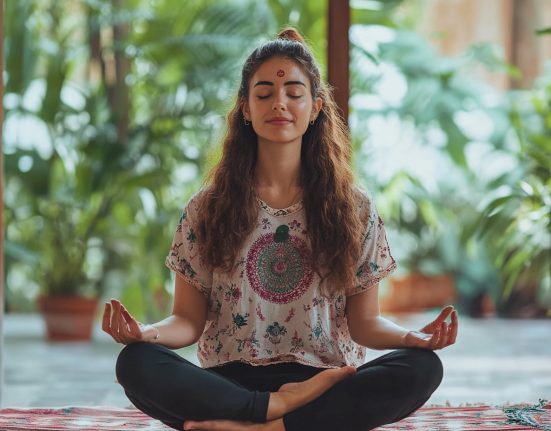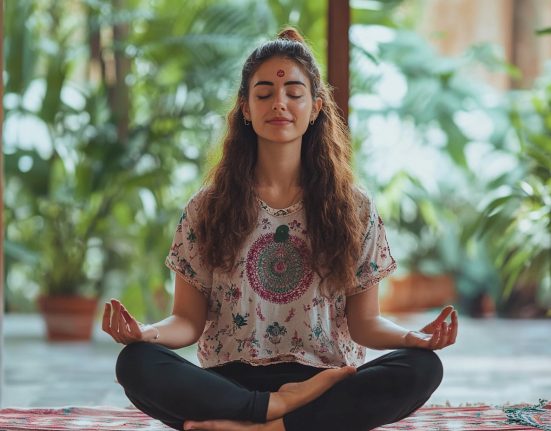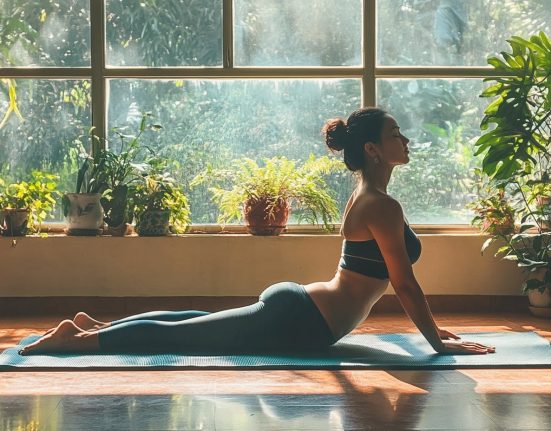Ashtanga yoga, a dynamic and structured practice, has grown in popularity among fitness enthusiasts of all levels.
This ancient form of yoga, characterized by its sequence of poses and focus on breath, offers unique benefits for both the mind and body.
Whether you’re a seasoned yogi or just starting out, understanding how to approach this practice can make a significant difference in your experience and results.
This blog will provide seven practical tips to help both beginners and experienced practitioners get the most out of their Ashtanga yoga practice.
These tips will cover everything from foundational techniques to ways to integrate the practice into your daily routine.
What are the key points of Ashtanga yoga?
Ashtanga yoga, known for its potential to improve strength, flexibility, and mental focus, is a practice suited for everyone, regardless of their fitness level. Here are seven practical tips to help enhance your Ashtanga yoga practice.
1. Grasping the basics
Grasping the basics of Ashtanga yoga is like laying the foundation for a strong and enduring building.
This practice isn’t just about performing poses; it’s about understanding the rhythm and flow that connect the body, breath, and mind.
Each movement in Ashtanga yoga is tied to your breath. Inhale as you extend or stretch, and exhale as you fold or contract. This synchronization enhances focus and internal heat, which is vital for deepening your practice.
Drishti, or focused gaze, is a key element. Each pose has a specific point where you direct your gaze. This helps maintain balance and deepens concentration.
Don’t rush. It’s better to practice a few poses correctly than to rush through an entire series. Over time, as you become more comfortable, you can gradually add more poses to your routine.
Consistency is key. Regular practice, even if it’s just a few poses each day, can lead to significant improvements over time.
2. Importance of breath work
Breath is the cornerstone of Ashtanga yoga, acting as a bridge between the body and mind. This style of yoga uses a specific breathing technique known as Ujjayi Pranayama, which is essential for enhancing your practice.
This breathing technique involves inhaling and exhaling through the nose with a slight constriction in the back of your throat. It sounds a bit like the ocean or a whisper. This method helps in maintaining rhythm and focus throughout your practice.
Your breath should guide your movements in Ashtanga yoga. Inhale as you extend, and exhale as you fold. This synchronization not only keeps you focused but also deepens the effectiveness of each pose.
Ujjayi breathing creates warmth in your body, which is crucial for increasing flexibility and cleansing toxins.
It’s like turning on your internal heater, preparing your body for the physical aspects of the practice.
The sound of Ujjayi breath is a tool for meditation. It keeps you anchored in the present moment, enhancing mental clarity and focus.
Like any skill, mastering Ujjayi breathing takes regular practice. Start by being mindful of your breath during simple activities and gradually integrate it into your yoga practice.
3. The role of bandhas
Understanding bandhas, or energy locks, is crucial in Ashtanga yoga. They’re like secret tools that enhance your practice, helping with stability, strength, and focus. There are two main bandhas you should be familiar with:
- Mula Bandha (root lock): This is activated by gently contracting the muscles at the pelvic floor. Imagine you’re trying to stop the flow of urine. Engaging Mula Bandha gives you a sense of stability and lightness, particularly in poses where balance is key.
- Uddiyana bandha (abdominal lock): To engage this, exhale fully and gently pull your navel towards your spine. This lock is typically engaged during breathing pauses and helps strengthen your core, supporting your spine and improving digestion.
Here’s how to incorporate bandhas into your practice:
- Initially, focus on simply being aware of these areas during your practice. It’s about building a mind-body connection.
- Begin by engaging these locks gently. It’s not about force but rather about finesse and control.
- Once you’re comfortable, start incorporating bandhas into different poses. Notice how they affect your stability and concentration.
4. Developing a consistent practice routine
Consistency is the key to unlocking the full benefits of Ashtanga yoga. Think of your practice like watering a plant [3]. Regular, consistent care is what helps it grow and thrive. Here’s how you can build a consistent practice:
- Set realistic goals: Start with achievable targets. If you’re new to yoga, committing to an hour every day might be overwhelming. Begin with shorter sessions a few times a week and gradually increase the duration and frequency.
- Create a routine: Try to practice at the same time each day. This helps establish yoga as a regular part of your schedule, just like eating or sleeping.
- Track your progress: Keep a yoga journal or use an app. Documenting your practice can be incredibly motivating. It’s rewarding to look back and see how far you’ve come.
- Be patient with yourself: Some days will be better than others. If you miss a day, don’t be hard on yourself. The most important part is to get back on the mat and continue your practice.
- Find a practice buddy: Partnering with a friend can boost your motivation. You can encourage each other and share your experiences.
5. Listening to your body
Listening to your body is a fundamental aspect of practicing Ashtanga yoga. It’s about tuning into your body’s signals and respecting its limits.
This approach not only prevents injuries but also deepens your connection with your practice. Here are some tips on how to listen to your body:
Recognize that every day is different. On some days you might feel strong and flexible, while on others, certain poses might feel more challenging. Respect these variations.
Your breath is a great indicator. If you find yourself struggling to breathe smoothly, it might be a sign to ease up.
There’s no shame in modifying poses. Use props or adapt the pose to suit your body. Yoga is not about perfection; it’s about practicing in a way that benefits your body.
A little discomfort is normal, but sharp or intense pain is a red flag. If a pose hurts, ease out of it and try a gentler variation.
Regularly ask yourself how you’re feeling. Are you pushing too hard? Could you challenge yourself a bit more? Being honest with yourself is key.
6. The importance of patience and persistence
Patience and persistence are vital in Ashtanga yoga. The journey towards mastering this practice is gradual and requires a steady commitment. Here’s how you can cultivate these qualities:
- Understand that progress in Ashtanga yoga doesn’t happen overnight. It’s a gradual process that unfolds uniquely for each individual.
- Acknowledge and celebrate your achievements, no matter how small. Maybe you held a pose a little longer or felt more relaxed during your practice.
- There will be days when you feel like you’re not making progress. It’s important to stay committed and keep practicing. Remember, every little bit adds up over time.
- On days when you feel less motivated or your practice doesn’t go as planned, be kind to yourself. Patience is also about being gentle with your own expectations.
- Ashtanga yoga is not just a physical practice; it’s a learning journey. Stay curious and open to learning new aspects of the practice, whether it’s about deepening your poses or understanding yoga philosophy.
7. Seek guidance and community
Seeking guidance and finding a community can significantly enhance your Ashtanga yoga experience.
Whether you’re a beginner or an experienced practitioner, the support and knowledge of others can be invaluable.
A knowledgeable teacher can provide personalized guidance, ensuring you’re practicing safely and effectively. They can offer adjustments, recommend modifications, and help deepen your understanding of the practice.
Being part of a class allows you to learn from others, share experiences, and stay motivated. It’s also a great way to make friends who share your interest in yoga.
Workshops can offer deeper insights into specific aspects of Ashtanga yoga, like advanced poses, breathing techniques, or philosophy.
If you can’t find local classes or communities, look online. There are many online forums, social media groups, and virtual classes where you can connect with fellow yoga enthusiasts.
Yoga retreats can be a wonderful way to immerse yourself in your practice, learn from different teachers, and meet people from diverse backgrounds.
Who is Ashtanga yoga ideal for?
Ashtanga yoga is a versatile practice that welcomes a wide range of individuals, making it accessible and beneficial for many:
- Beginners: Those new to yoga can start with modified versions of poses, gradually advancing as they build strength and flexibility.
- People seeking stress relief: The meditative aspects of synchronized breathing and movement offer effective stress relief and mental clarity.
- Seasoned practitioners: Experienced yogis find Ashtanga yoga beneficial for deepening their practice and exploring more challenging poses.
- Individuals with specific health goals: Whether it’s improving flexibility, building strength, or enhancing cardiovascular health, Ashtanga yoga can be tailored to meet various health objectives.
- Athletes: Ashtanga’s focus on strength, flexibility, and endurance makes it an excellent cross-training option for athletes.
- Older adults: With appropriate modifications and a focus on gentle movements, older adults can safely practice Ashtanga yoga, benefiting from its ability to maintain flexibility and balance.
Ashtanga yoga is adaptable to different skill levels and physical conditions, making it a suitable practice for almost anyone looking to improve their physical and mental well-being.
Conclusion
As we wrap up this guide on Ashtanga yoga, remember that your practice is a personal journey. It’s about growth, both on and off the mat.
Whether you’re just starting or have been practicing for years, the key is to stay committed, patient, and open to learning.
Ashtanga yoga is more than just a physical practice; it’s a pathway to discovering your strength, flexibility, and inner peace. Every time you step on the mat, you have an opportunity to explore and grow.
FAQs
What are the key points of Ashtanga yoga?
Ashtanga yoga is characterized by a specific sequence of poses, synchronized breathing, and the use of bandhas (energy locks) and drishti (focused gaze).
How often should you practice Ashtanga yoga?
For beginners, it’s recommended to practice Ashtanga yoga three times a week, but as you gain more experience, you can increase this to daily practice for more profound benefits.
What are the benefits of doing Ashtanga yoga?
Practicing Ashtanga yoga regularly improves physical strength and flexibility, enhances mental clarity, and promotes a sense of inner peace and well-being.
Is Ashtanga suitable for beginners?
Yes, Ashtanga is suitable for beginners, with modifications and guidance allowing practitioners of all levels to engage in the practice.









